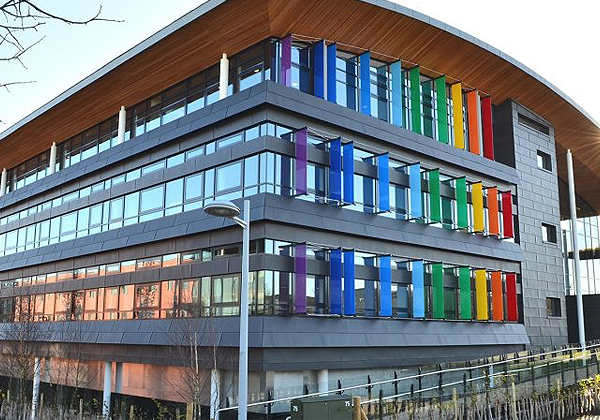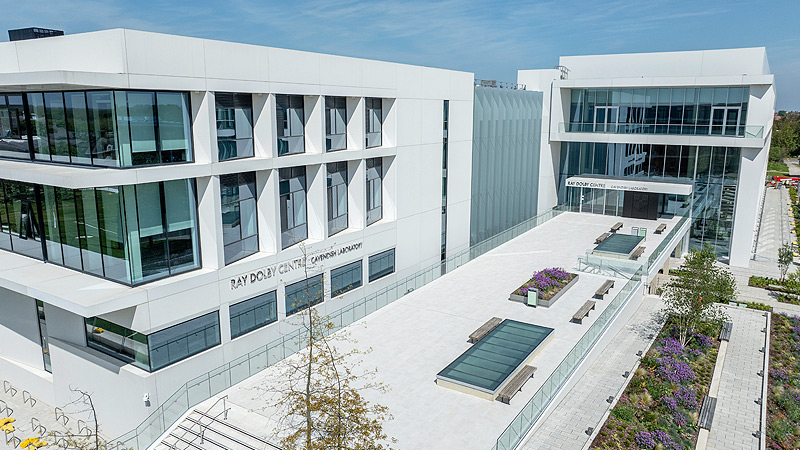Research labs and Facilities
Groundbreaking research in cutting-edge facilities
The Department of Physics is based at the heart of the Cambridge West Innovation District (Cambridge West), which has become a world-renowned centre of scientific research, innovation and commercialisation. Cambridge itself is Europe’s largest technology cluster and an environment where links between the University and industry are nurtured, leading to £24bn in annual turnover from knowledge-intensive firms.
The Whittle Laboratory and the Department of Computer Science and Technology are close neighbours, along with the British Antarctic Survey, Nanoscience Centre, Cambridge Enterprise and the West Hub co-working and collaboration space.
The Ray Dolby Centre
Our state-of-the-art facility is the new centrepiece of the Cavendish Laboratory. Bright and spacious, the contemporary architecture captures our sense of possibility and our collective aspiration for the future of physics.
The Centre is home to most of our research themes, with dozens of laboratories covering the full breadth of physics research, and collaborative working spaces for researchers and students. It’s also where you’ll find CORDE – the Collaborative R&D Environment for physics – which gives access to our equipment, resources and knowledge to university and industry researchers across the UK.
It’s a deliberately open space. Spanning five floors, with one single entry point into the building, you’ll see academics, professionals and commercial partners mingling together, all with a sense of where they belong in the bigger picture.
It’s all part of our expansive, interdisciplinary approach which has placed us at the forefront of discovery since 1874 and always setting the pace for the future.
- Extensive research and teaching labs, with numerous clean rooms, cryostat halls, microscopy suites and laser and optical labs
- Multiple teaching and learning spaces, including a 400-seat lecture theatre, teaching labs for undergraduates, a learning resource centre, outreach and exhibition spaces
- Café and meeting areas to enable discussion and study
The Centre was named in recognition of a generous £85 million gift from the estate of Cambridge alumnus and sound pioneer Dr Ray Dolby. An additional £75m contribution from the UK government, through the Engineering and Physical Sciences Research Council (EPSRC), combined to form an unrivalled scale of investment which will act as a springboard for scientific breakthroughs and create positive, real-world impact.
The Maxwell Centre
Opposite the Ray Dolby Centre is the Maxwell Centre, the catalyst for industrial engagement with Physical Sciences and Technology. It is a vibrant hub of research and innovation, and home to several research groups, including physicists across multiple research themes.
The Centre fosters a dynamic exchange between academia and industry through a range of programmes and activities, which nurtured numerous startups, industrial collaborations and commercial opportunities.
It also hosts several industrial partners, the Cambridge Zero initiative, several University strategic Research Interdisciplinary Centres and graduate training programmes, as well as the Cambridge spoke of the Henry Royce Institute for Advanced Materials Research.
Physics of Medicine
Next door to the Maxwell Centre is the Physics of Medicine (PoM) building, a dynamic hub of research at the intersection of biology and medicine.
As a key facility for the Physics of Life research theme, PoM provides labs, teaching space and essential infrastructure for biological and biomedical research, fostering collaboration across various departments within the University.
Our researchers have strong ties to the Schools of Biological Sciences and Clinical Medicine, leading initiatives like the Centre for Physical Biology and the Precision Health Initiative. Access to the extensive research facilities of the PoM building is also available for external users.
Battcock Centre for Experimental Astrophysics
Connected to the Institute of Astronomy and the Kavli Institute, the Battcock Centre brings together the disciplines of Astronomy, Astrophysics and Cosmology and offers continual opportunities to collaborate between disciplines.
Numerous international projects see us pushing the boundaries of astrophysical knowledge, such as the James Webb Space Telescope (JWST), CHEOPS (CHaracterizing ExOPlanet Satellite) and REACH (Radio Experiment for the Analysis of Cosmic Hydrogen).
Mullard Radio Astronomy Observatory (MRAO)
Supporting the Astrophysics research at the Cavendish since the 1950s, the MRAO enables research in radio astronomy and contributes to a far deeper understanding of the universe.
It hosts aperture synthesis radio telescopes, including the One-Mile Telescope, 5-km Ryle Telescope, and the Arcminute Microkelvin Imager.

